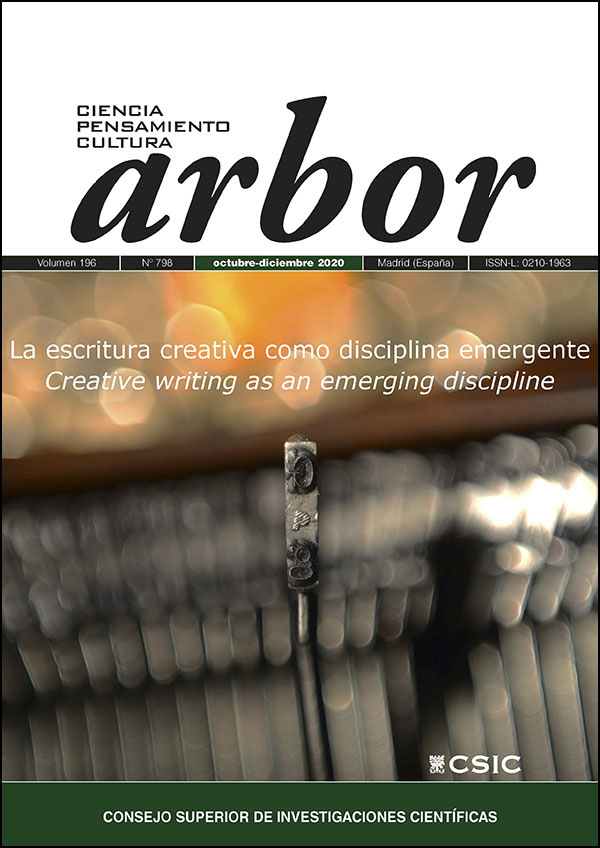Brief forms and creative writing: an open door to imagination
DOI:
https://doi.org/10.3989/arbor.2020.798n4005Keywords:
Creative writing, short story, minimal theatre, experimentation, twitterature, SMS literatureAbstract
Over recent decades, creative writing has come to occupy a relevant place. This socio-cultural demand is manifested in the rise of specialized workshops and masters courses. Writing with correctness and originality is, without a doubt, an attractive and ambitious goal. It involves teachers and students in a teaching-learning process where short forms show a unique field of experimentation. Thus, the short story and minimal theatre constitute literary models that demonstrate, in their minimalist formats, a wide range of creative possibilities. Border micro-stories, above all, constitute a highly-interesting space of experimentation for their hybridization with journalism and poetry. Mini-pieces can also reach a certain mestizo profile, such as the dramatic snippets of Moreno Arenas, the border theatre or minor theatre of Sanchis Sinisterra, or the lyric micro-theatre of Antonia Bueno. Short forms also act as a bridge to new technologies.
Downloads
References
Alder, Harry (2003). Inteligencia creativa. México D.F.: Aguilar.
Andrés-Suárez, Irene (2012). Antología del microrrelato español (1906-2011). Madrid: Cátedra.
Ayala, Francisco (1999). El jardín de las delicias. Madrid: Alianza Editorial.
Carrillo, Nuria (1997). El cuento literario español en la década de los 80. Madrid: Fidescu.
Enríquez, Salvador (2001). La miniatura como arte escénico. En: José Moreno Arenas. 13 minipiezas. Valencia: Ediciones Art Teatral, pp. 6-7.
González, Henry (2004). La didáctica del minicuento y su desarrollo en ambientes hipermediales. En: Francisca Noguerol Jiménez (ed.). Escritos disconformes. Nuevos modelos de lectura. Salamanca: Ediciones Universidad de Salamanca, pp. 303-315.
Gutiérrez Carbajo, Francisco (2013). Teatro breve actual. Madrid: Castalia.
Lagmanovich, David (2006). El microrrelato. Teoría e historia. Palencia: Menoscuarto.
Lorenzin, María Elena (2004). Fast Fiction en la clase de español avanzado: Una experiencia creativa en las Antípodas. En: Francisca Noguerol (ed.). Escritos disconformes. Nuevos modelos de lectura. Salamanca: Ediciones Universidad de Salamanca, pp. 317-333.
Marín Ibáñez, Ricardo (1984). La creatividad. Barcelona: Ceac.
Mayorga, Juan (2001). Teatro para minutos. Ciudad Real: Ñaque.
Merino, José María (1997). Reflexiones sobre el cuento. En: Ángeles Encinar y Anthony Percival (eds.). Cuento español contemporáneo. Madrid: Cátedra, pp. 142-143.
Merino, José María (2005). Cuentos del libro de la noche. Madrid: Santillana.
Millás, Juan José (2011). Ariticuentos completos. Barcelona: Seix Barral.
Moreno Arenas, José (2003). Teatro mínimo (Pulgas dramáticas). Granada: Ediciones Dauro.
Navarro Romero, Rosa María (2009). El microrrelato: género literario del siglo XXI. En: Salvador Montesa (ed.). Narrativas de la posmodernidad. Del cuento al microrrelato. Málaga: AEDILE, pp. 443-456.
Nieto de Diezmas, Esther y Castellanos Segura, José Luis (2011). La narrativa hiperbreve en la Red: nuevos lectores y nuevos escritores. En: Salvador Montesa (ed.). Literatura e internet. Nuevos textos, nuevos lectores. Málaga: AEDILE, pp. 413-424.
Obligado, Clara. (2004). La creación de textos mínimos. En: Francisca Noguerol (ed.). Escritos disconformes. Nuevos modelos de lectura. Salamanca: Ediciones Universidad de Salamanca, pp. 335-344.
Orihuela, José Luis (2017). El instantáneo éxito en Twitter del relato de ficción en tiempo real de @ManuelBartual se inscribe en la tradición del género #twitteratura, que se remonta hasta los primeros años de la plataforma. Disponible en: https://www.ecuaderno. com/2017/08/28/la-historia-de-manuelbartual-y-el-redescubrimiento-de-la-twitteratura/ [Fecha de consulta: 13 de octubre de 2019].
Sanchis Sinisterra, José (1995). Mísero Próspero y otras breverías (Monólogos y diálogos). Madrid: La Avispa.
Sanchis Sinisterra, José (2008). Teatro menor. Ciudad Real: Ñaque.
Tomeo, Javier (1988). Historias mínimas. Madrid: Mondadori.
Tusquets, Esther (1997). Reflexiones sobre el cuento. En: Ángeles Encinar y Anthony Percival (eds.). Cuento español contemporáneo. Madrid: Cátedra, pp. 285- 286.
Valls, Fernando (2005). El microrrelato o la apuesta por un género nuevo. En: Neus Rotger y Fernando Valls. Ciempiés. Los microrrelatos de Quimera. Barcelona: Montesinos.
Vargas Llosa, Mario (2005). Diario de Irak. Madrid: Punto de Lectura.
Vicent, Manuel (1984). Crónicas urbanas. Madrid: Debate.
Zavala, Lauro (2004). Cartografías del cuento y de la minificción. Sevilla: Renacimiento.
Zavala, Lauro (2005). La minificción bajo el microscopio. México D.F.: Universidad Pedagógica Nacional.
Zurro, Alfonso (1994). Bufonerías. Teatro para cómicos de la lengua. Sevilla: Galaor.
Zurro, Alfonso (2014). Cien viajes en ascensor. Sevilla: La Jácara.
Published
How to Cite
Issue
Section
License
Copyright (c) 2021 Consejo Superior de Investigaciones Científicas (CSIC)

This work is licensed under a Creative Commons Attribution 4.0 International License.
© CSIC. Manuscripts published in both the printed and online versions of this Journal are the property of Consejo Superior de Investigaciones Científicas, and quoting this source is a requirement for any partial or full reproduction.
All contents of this electronic edition, except where otherwise noted, are distributed under a “Creative Commons Attribution 4.0 International” (CC BY 4.0) License. You may read the basic information and the legal text of the license. The indication of the CC BY 4.0 License must be expressly stated in this way when necessary.
Self-archiving in repositories, personal webpages or similar, of any version other than the published by the Editor, is not allowed.














